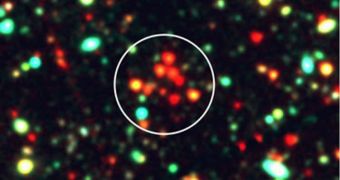While analyzing a portion of the night sky in the direction of the constellation Leo, astronomers were recently able to discover the oldest known cluster made up entirely of red galaxies. At the time when the formation released the light we are seeing now, the Universe was just 3 billion years old.
Astronomers behind the new survey say that the cluster was discovered in a portion of the high that had already been heavily investigated by a wide array of telescopes before this investigation began.
Ground- and space-based observatories alike could not detect the extremely faint formation, which is believed to lie about 10.5 billion light-years away. Scientists say that this should not be considered a failure, given how faint and distant the cosmic structure is.
Not even the NASA/ESA Hubble Space Telescope had sufficient resolve power to see this structure. This was made possible by the 6.5-meter Magellan Baade Telescope (MBT), which was recently outfitted with a new and sensitive near-infrared camera called FourStar.
At the time when it released the light we're detecting now, the structure contained just 30 galaxies. In the meantime, it's possible that it developed into a galactic supercluster, or maybe even a galactic wall.
“This means the galaxy cluster is still young and should continue to grow into an extremely dense structure possibly containing thousands of galaxies,” astronomer Lee Spitler explains. The expert holds an appointment as a researcher at the Swinburne University of Technology, in Australia.
He is also the lead author of the new investigation. The FourStar Galaxy Evolution Survey (Z-FOURGE) was led by Dr. Ivo Labbé, from the Leiden Observatory, in the Netherlands, Daily Galaxy reports. The MBT is located at the Las Campanas Observatory, in Chile.
Astrophysicists find it very interesting that such a cluster could have developed so early after the Big Bang. The Universe concluded its reionization epoch about 1.1 billion years after it rapidly expanded into being.
This means that this particular cluster was made out of galaxies that were themselves created, and then put together, in about 2 billion years. This is a relatively short time frame for a cosmic process that usually takes a long time to complete.

 14 DAY TRIAL //
14 DAY TRIAL //